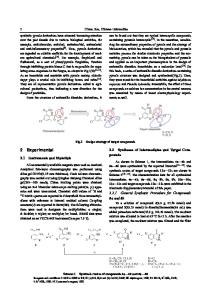Synthesis and ROMP of Metal Nanocluster Containing Norbornene Derivatives
- PDF / 137,623 Bytes
- 5 Pages / 612 x 792 pts (letter) Page_size
- 74 Downloads / 383 Views
Synthesis and ROMP of Metal Nanocluster Containing Norbornene Derivatives James H. Wynne, Christopher T. Lloyd, Steven E. Bullock and Robert F. Cozzens Naval Research Laboratory, Code 6125 Washington, DC 20375, U.S.A. ABSTRACT We report the synthesis of a series of highly functional metal chelated silyl- and tert-butylprotected 2,3-diaminomethyl norbornene derivatives. Subsequent alterations to the previously synthesized norbornene adducts afford many other derivatives containing such functionalities as alkyl, cyano, esters, and ethers. These derivatives are then subjected to ring-opening metathesis polymerization (ROMP) employing a ruthenium homogeneous catalyst to afford phase separated block polymers. The block polymers formed serve as unique templates for the formation of size controlled metal nanoclusters having a narrow dispersion. These metal nanoclusters containing diblock polymers are evaluated as unique electrical and optical materials. INTRODUCTION With the ever-increasing demand for new and novel functional materials and smaller devices, so is the demand for new routes and controls on the size and composition of nano-particulate materials [1-2]. The goal of this project is to synthesize metal containing diblock polymers that self-assemble to form metal, (i.e. Au, Ag, Cd) nanoclusters. These compounds are of particular interest due to their large non-linear optical (NLO) properties and unique electrical properties as has been demonstrated from materials formed in other ways [3-5]. Ideally the diblock nanocluster containing polymers should be optically transparent, electrically conducting, flexible, robust, functionalized and capable of forming thin polymer films. Possible applications include flexible transparent conducting layers for MEMS applications such as optical shutter arrays, commonly referred to as the artificial eyelid [6-8]. EXPERIMENTAL DETAILS The employment of ROMP provides a route to novel functionalized norbornene derivatives, which are otherwise not commercially available. Synthesis of the norbornene monomers was performed using a modified Diels-Alder reaction. Condensation of freshly cracked cyclopentadiene with several dienophiles resulted in the formation of compounds 1 and 2 (Fig. 1). Subsequent transformations of these two molecules afforded the corresponding derivatives 39 in good yields. Compounds 5 and 8 were treated with base followed by the addition of gold (I) chloride to afford 10 and 11 respectively. Due to the sensitivity of the reagent toward both oxygen and moisture, all polymerization reactions were carried out in an inert atmosphere. Upon monomer formation, the respective di-block polymer syntheses ensued employing the widely reported Grubbs Catalyst, (Benzylidene-bis(tricyclohexylphosphine)dichlororuthenium; C43H72Cl2P2Ru) [9-11] with norbornene employed as block A while block B was one of the newly synthesized monomers 1-9. In each case, special care was taken to ensure that the desired block length was controlled by stoichiometry, it was determined that several monome
Data Loading...











